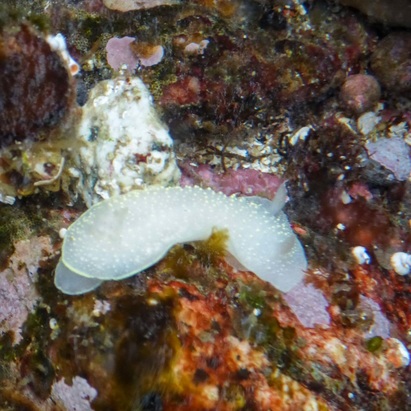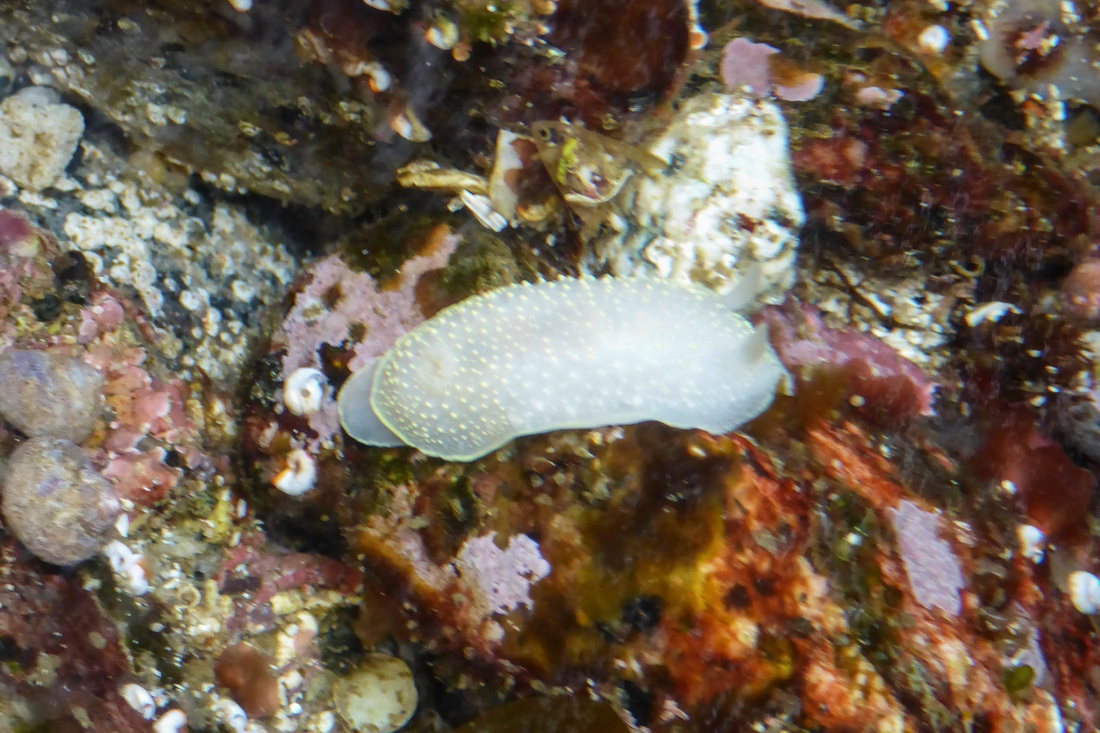Yellow-rimmed nudibranch • Cadlina luteomarginata
Identification
The yellow-rimmed nudibranch has a white, pale cream, or pale yellow oval-shaped body with a lemon yellow margin edging both its body (mantle) and its foot, which may be seen sticking out from beneath the mantle during movement. Rounded, stubby tubercles (bumps) tipped with lemon yellow cover its dorsal surface. The small gill plume is pale cream or pale yellow. While this nudibranch is commonly around 2.5 cm long, individuals have been recorded at more than 3 times that size.
Habitat & Range
This fairly common dorid nudibranch inhabits rocky areas with sponges (on which it feeds), in the intertidal and subtidal to 45 m deep. Its range extends from northern Alaska to Baja California, Mexico.
Similar Species
There are a number of white or off-white dorid nudibranchs found in the Pacific Northwest. The most similar of these to the yellow-rimmed nudibranch is the less common Hudson's dorid (Acanthodoris hudsoni), which also has yellow-tipped bumps and a yellow foot margin. The differences between the two are obvious upon comparison, however: Hudson's dorid has pointed papillae and distinctly longer rhinophores. Other similar dorids lack the yellow rim and rhinophore tips or have additional colouring, as in the case of the Nanaimo dorid (Acanthodoris nanaimoensis), which has red-tipped gills and rhinophores.
The yellow-rimmed nudibranch has a white, pale cream, or pale yellow oval-shaped body with a lemon yellow margin edging both its body (mantle) and its foot, which may be seen sticking out from beneath the mantle during movement. Rounded, stubby tubercles (bumps) tipped with lemon yellow cover its dorsal surface. The small gill plume is pale cream or pale yellow. While this nudibranch is commonly around 2.5 cm long, individuals have been recorded at more than 3 times that size.
Habitat & Range
This fairly common dorid nudibranch inhabits rocky areas with sponges (on which it feeds), in the intertidal and subtidal to 45 m deep. Its range extends from northern Alaska to Baja California, Mexico.
Similar Species
There are a number of white or off-white dorid nudibranchs found in the Pacific Northwest. The most similar of these to the yellow-rimmed nudibranch is the less common Hudson's dorid (Acanthodoris hudsoni), which also has yellow-tipped bumps and a yellow foot margin. The differences between the two are obvious upon comparison, however: Hudson's dorid has pointed papillae and distinctly longer rhinophores. Other similar dorids lack the yellow rim and rhinophore tips or have additional colouring, as in the case of the Nanaimo dorid (Acanthodoris nanaimoensis), which has red-tipped gills and rhinophores.
References
Harbo, R. M. (1999). Whelks to whales: Coastal marine life of the Pacific Northwest. Madeira Park, BC: Harbour Publishing. P. 114.
Lamb, A., and Hanby, B. (2005). Marine Life of the Pacific Northwest [electronic version]. Madeira Park, BC: Harbour Publishing.
McDonald, G. Cadlina luteomarginata MacFarland, 1905. Intertidal Invertebrates of the Monterey Bay Area, California. Long Marine Laboratory, University of California, Santa Cruz. Acccessed 28/06/2016.
Authors and editors of page
Kelly Fretwell (2016).
Harbo, R. M. (1999). Whelks to whales: Coastal marine life of the Pacific Northwest. Madeira Park, BC: Harbour Publishing. P. 114.
Lamb, A., and Hanby, B. (2005). Marine Life of the Pacific Northwest [electronic version]. Madeira Park, BC: Harbour Publishing.
McDonald, G. Cadlina luteomarginata MacFarland, 1905. Intertidal Invertebrates of the Monterey Bay Area, California. Long Marine Laboratory, University of California, Santa Cruz. Acccessed 28/06/2016.
Authors and editors of page
Kelly Fretwell (2016).





